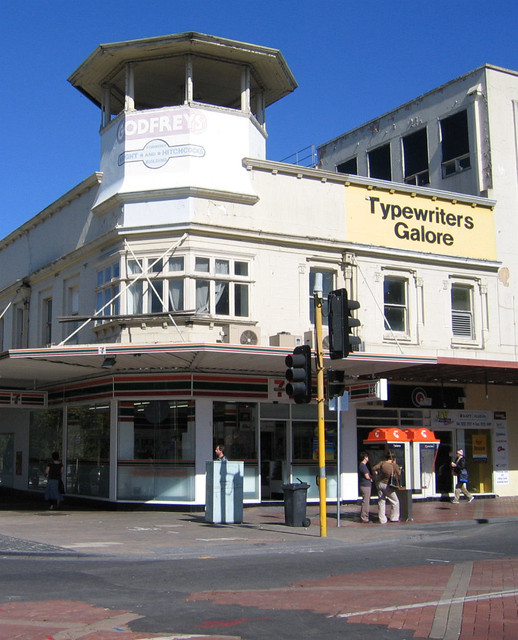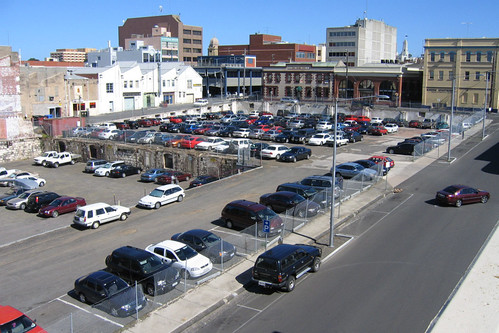Another instalment in my photos from ten years ago series – this time February 2006.
First off is a ghost sign for “Typewriters Galore” found on Moorabool Street – the main street of Geelong. When was the last time anyone bought a typewriter, let along visited a store dedicated to them?
I also paid a visit to the site of Geelong’s former Bow Truss Building – the largest reinforced concrete roof in the world until it was controversially demolished in 1990, with the site sitting empty for two decades, until the TAC offices were built on the site.
Back in Melbourne a massive concrete deck was taking shape over platforms 13-16 at Southern Cross Station.
A massive crawler track crane parked in the middle of Wurundjeri Way was used to lift the precast components into place.
Trains were also being use to bring wagons of building material to and from the worksite.
February 3 saw the official completion of the Regional Fast Rail upgrades to the Geelong line, when Victorian Premier Steve Bracks and Transport Minister Peter Batchelor cutting the ribbon.
From this date new VLocity trains started to take over from older rolling stock on the Geelong line – back then two carriage long trains once an hour was considered enough to handle the patronage.
And finally, at Southern Cross Station I spotted a failed Sprinter train in need of help, with an N class diesel locomotive being used to tow it back to the workshops.
Footnote
With the current VLocity level crossing debacle we are seeing similar movements of diesel hauled railcars, with VLocity trains having to be hauled by diesel locomotives to the workshops at Newport and Dandenong.
Further reading
The full photos from ten years ago series.








I had no idea that the development above Southern Cross had been so long in the making. I thought the new supports on Platforms 13-16 were part of the RRL Expansion.
Obviously my infrequent trips to Melbourne compared to my frequent ones now have skewed my memories
Here is a model dating to 2006 at the latest – an office podium at the west end was part of the original plan:
https://railgallery.wongm.com/southern-cross-station/286_8616.jpg.html
This aerial photo from 2007 shows the deck under construction:
http://www.cityofsound.com/blog/images/melbourne_blooming_large.jpg
Back then the provision for platforms 15 and 16 was intended for the Melbourne Airport rail link.
Regarding typewriters I think I was about the last of the high school students to use them during Year 7 and 8 in the early 1990’s. Our school was only opened in 1986 with building work being done in stages in the late 80’s and early 90’s as the student numbers grew (progressively adding Year 10-11-12) and the original portables replaced.
The first 3-level building they built in 1990-91 had two computer rooms (replacing the original ground floor one) facing the balcony with a ‘Keyboarding’ room in between – a room full of new Brother electric typewriters. I remember at the time thinking why they bothered with typewriters back then and needless to say few took it as an elective in Year 9.
After the Windows 95 hype they finally saw fit to dispense with them and turn it into a third computer room when they went about upgrading the other two to new machines.
A colleague at work surprised me a few years ago – she wasn’t much older than me yet took ‘keyboarding’ classes at school.
By the time I was in primary school keyboarding was still around – but with ‘Mavis Beacon Teaches Typing’ on a Mac.
It was called “keyboarding” class when I did it in the 90s, mainly just typing practice. I went through the all of high school with just BBC micros from 1989 to 1994. The school went through a major upgrade in the late 90s with new technology, facilities and more students. Lucky since it was getting a bit run down when I was there but it did have good teachers. I did not even do computing in year 12 as there were not enough students to get it taught at the school.
In 1992 my primary school also had BBC Micros –
https://en.wikipedia.org/wiki/BBC_Micro
The keyboard was weird compared to modern ones, and I still remember the special instruction sheets that sat above the F-key row, letting you know the shortcut keys for each program.